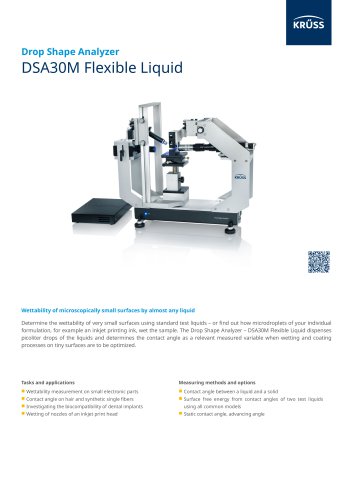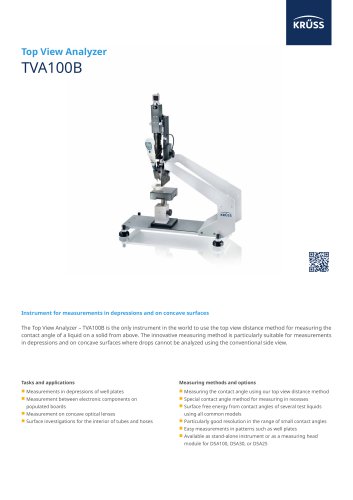 Website:
KRÜSS GmbH
Website:
KRÜSS GmbH
Group: Krüss
Catalog excerpts

Technical Note Practical contact angle measurement (4) Technical Note: Industry section: Drop Shape Analyzer – DSA100 Method: Keywords: methods, contact angle, sessile drop Measuring with method – but with which one? For computer-supported drop shape analysis mathematical models are used which describe the optically determined shape. The DSA software from KRÜSS provides various methods with different application and validity ranges for this. This fourth part on practical contact angle measurement gives an overview of the methods and mentions the criteria for selecting the most suitable method. The user of the historical goniometer for contact angles was not plagued by the choice of method: by using a scaled rotating disk a tangent was aligned to the drop shape by hand. Today the optical evaluation is carried out by camera and software, which on the one hand represents a great step toward high-resolution and reproducibility, while on the other hand requires more know-how from the user. Fig. 1: Sessile drop: a drop lying on the solid sample Selecting the drop type Captive Bubble Before carrying out the drop shape analysis the drop type must be selected in the DSA software. The drop type describes the arrangement of sample and drop in the image. The type to be selected therefore inevitably depends on the measuring setup used. With high-energy surfaces the user faces the problem that with each liquid a very small, hardly measurable contact angle is formed. It may also happen that the sample can only be measured when it is immersed in a liquid – soft contact lenses, for example. In such cases the captive bubble method is the classical method: instead of a drop an air bubble is deposited beneath a solid sample surrounded by a liquid phase. Sessile Drop The sessile drop is the standard arrangement for contact angle measurement. A drop lying on the solid surface forms a characteristic contact angle with the surface at the three-phase contact point. The angle measured within the bubble shape is not yet the contact angle between solid and liquid that we are looking for. This results from the difference between 180° and the bubble angle. The DSA programs carry out this calculation automatically. KRÜSS GmbH | Borsteler Chaussee 85 | 22453 Hamburg | Germany | www.kruss.de
Open the catalog to page 1
Models for contour analysis The drop contour is a curved line for whose mathematical description several models are implemented in the KRÜSS drop shape analysis programs (DSA). Fig. 2: Captive bubble: an air bubble sitting beneath a solid sample Pendant Drop The pendant drop is not used for contact angle measurements. In this setup a drop (as large as possible) hangs from a needle. If the image scale is known then the pendant drop shape can be used to calculate the surface tension of the liquid. The more that the actual contour follows the requirements of the model, the more suitable the...
Open the catalog to page 2
The Young-Laplace method takes the characteristic drop shape under the influence of gravity into account with a sophisticated iteration method. It is also used for determining the surface tension from the shape of a pendant drop (see above). Choice of a suitable model The criteria described in this section should help with the selection of the suitable model for the contour fit for the particular drop. Small or large contact angle? With small contact angles, particularly in combination with small volumes, the contour can be well described as an arc. For the lower measuring range up to 10°...
Open the catalog to page 3
Robustness Up to now it could be assumed that the polynomial method can be used for any shape and size of drop as well as for dynamic drops, so why not always use this method? The answer is that although the polynomial fit can analyze any imaginable curve shape in the contact region, it also reacts to interferences more sensitively than other methods. If the drop image is not flawless, then a "vertical flip" of the tangents can be observed sporadically - the measured angle bears no relationship to the actual value. The polynomial method requires a clean, high-contrast drop shape image to a...
Open the catalog to page 4All KRÜSS GmbH catalogs and technical brochures
-
DROP SHAPE ANALYZER – DSA30M
2 Pages
-
DSA30M Flexible Liquid
2 Pages
-
Product Overview 2025
84 Pages
-
Tensíío
2 Pages
-
Ayríís
2 Pages
-
FORCE TENSIOMETER – K20
2 Pages
-
FORCE TENSIOMETER – K6
1 Pages
-
TOP VIEW ANALYZER – TVA100B
2 Pages
-
DROP SHAPE ANALYZER – DSA30
2 Pages
-
DROP SHAPE ANALYZER – DSA30R
2 Pages
-
Drop Shape Analyzer DSA25
2 Pages
-
DROP SHAPE ANALYZER – DSA100
2 Pages
-
Dynamic Foam Analyzer DFA100
2 Pages
-
DSA100, DSA30, EasyDrop
5 Pages
-
DSA100, DSA30
4 Pages
-
DSA100
3 Pages































